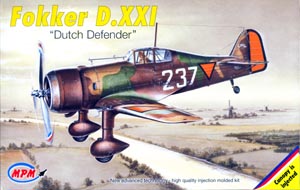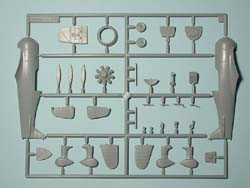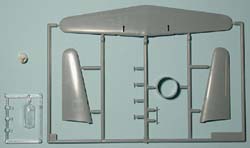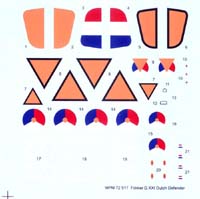MPM 1/72 Fokker D.XXI ‘Dutch Defender’ |  | The Kit  Here's a kit that has been a long time in coming. There are only three other 1/72 injection-molded kits of the Fokker D.XXI that I know of, the old Frog kit, the Pioneer kit, and the more recent Siga kit. This one looks to be much better than any of those three. The parts come in two sprues and are molded in a gray plastic. The detailing is sharp and the panel lines are recessed throughout. The clear parts are injection-molded and thin, and a single resin piece provides the spinner hub. The decals are well printed and thin, and although this particular kit had an alignment problem, other samples I've seen are well-aligned. Here's a kit that has been a long time in coming. There are only three other 1/72 injection-molded kits of the Fokker D.XXI that I know of, the old Frog kit, the Pioneer kit, and the more recent Siga kit. This one looks to be much better than any of those three. The parts come in two sprues and are molded in a gray plastic. The detailing is sharp and the panel lines are recessed throughout. The clear parts are injection-molded and thin, and a single resin piece provides the spinner hub. The decals are well printed and thin, and although this particular kit had an alignment problem, other samples I've seen are well-aligned.
Starting with the cockpit, this kit comes with a fairly detailed arrangement out of the box. The main floor has detail molded in place, and two rear bulkheads help fill the space behind the seat. Separate rudder pedals, an instrument panel, and a control stick help finish the interior, and the seat only needs a set of seatbelts. The finished cockpit assembly fits between the two fuselage halves, with a separate tailwheel and rudder finishing the main fuselage. Separate to the fuselage is the engine cowling, made up of two main pieces with separate parts for the carburetor intake and exhaust port. The propeller has plastic blades fitting into a resin hub.  The wings are made up of three pieces, with the one piece lower wing providing the dihedral. The landing gear has two-piece spats with separate wheels. The tailplanes are molded as right and left halves. The landing lights are separate clear parts, and the wings also have separate guns and a pitot tube. Final details are the canopy and gunsight. The wings are made up of three pieces, with the one piece lower wing providing the dihedral. The landing gear has two-piece spats with separate wheels. The tailplanes are molded as right and left halves. The landing lights are separate clear parts, and the wings also have separate guns and a pitot tube. Final details are the canopy and gunsight.
 The decals provide three options, all Dutch. All three are finished in green and two shades of brown. The first option, number 215, is from the 1st Fighter Squadron out of Schipol sometime before October 1939 and has the standard Dutch red, white and blue roundels with orange center dots. The rudder is also painted in red, white and blue. The second option, number 237, is a late autumn 1939 plane with the orange triangle national markings. The final option, white 227, has a combination of both early and later national markings. The decals provide three options, all Dutch. All three are finished in green and two shades of brown. The first option, number 215, is from the 1st Fighter Squadron out of Schipol sometime before October 1939 and has the standard Dutch red, white and blue roundels with orange center dots. The rudder is also painted in red, white and blue. The second option, number 237, is a late autumn 1939 plane with the orange triangle national markings. The final option, white 227, has a combination of both early and later national markings.
Conclusion This is a great little model of an interesting fighter. I don’t doubt that we will soon see a Finnish example as well. If you have been wanting to build a model of a Fokker D.XXI but did not want to tackle the Frog kit, your wait is over. | 








|
